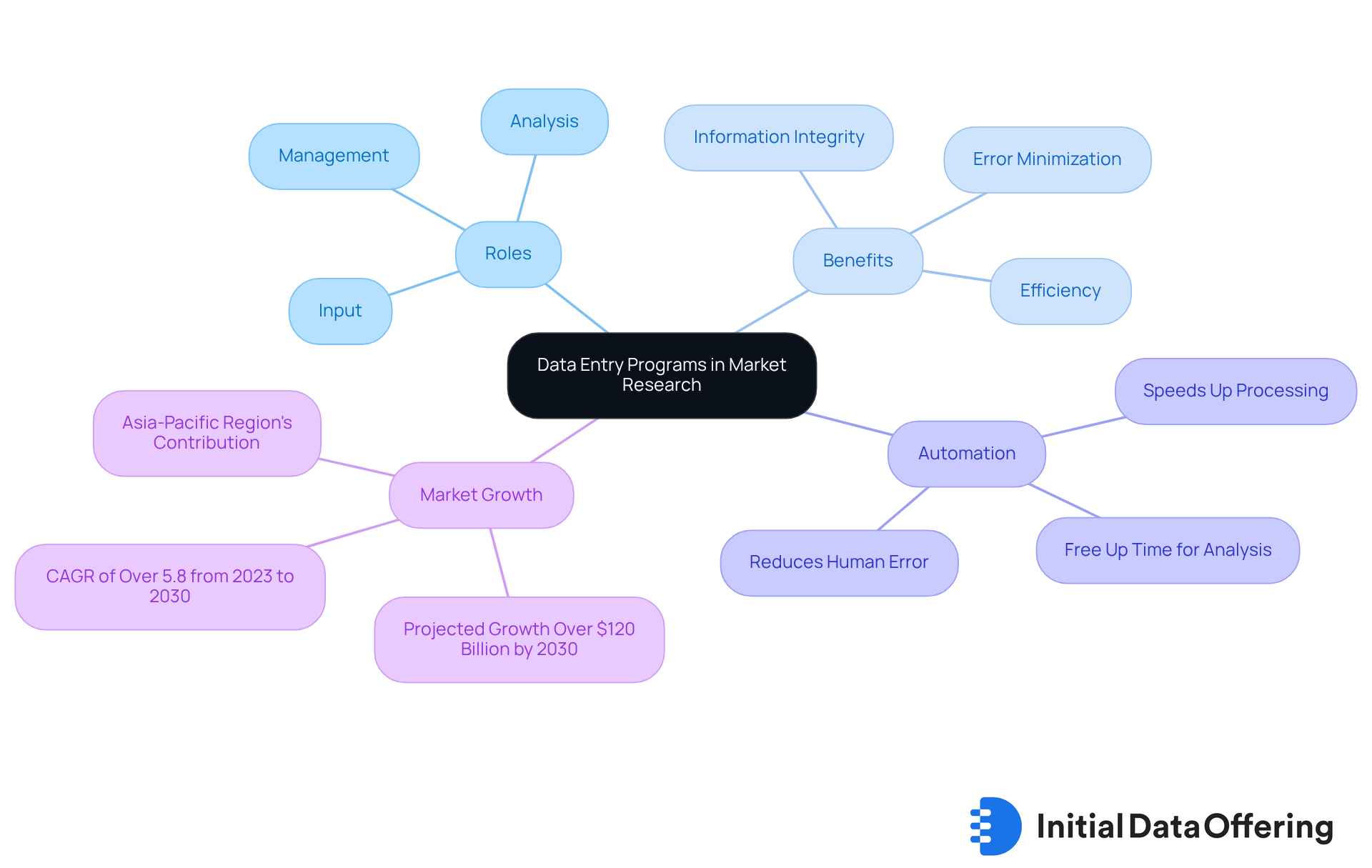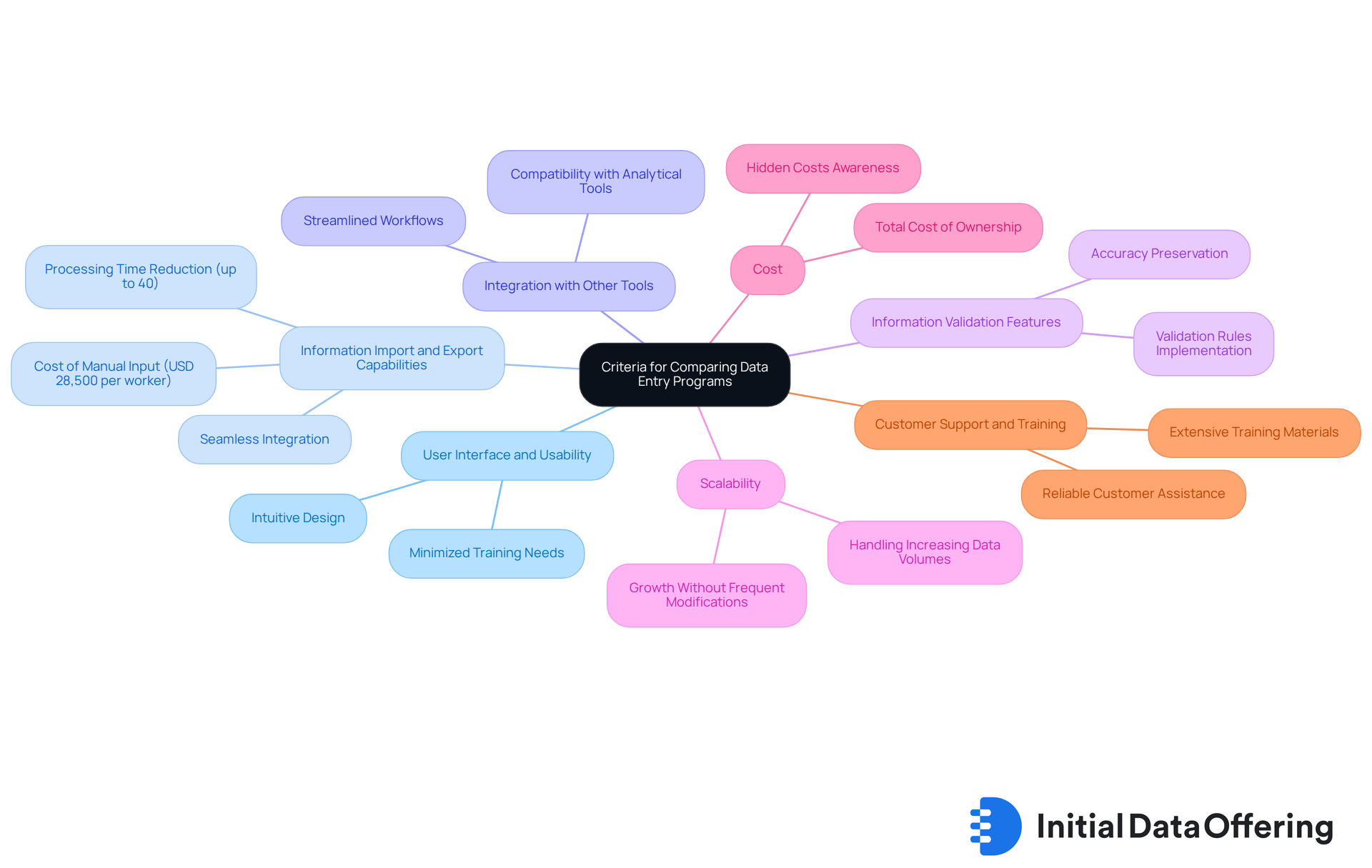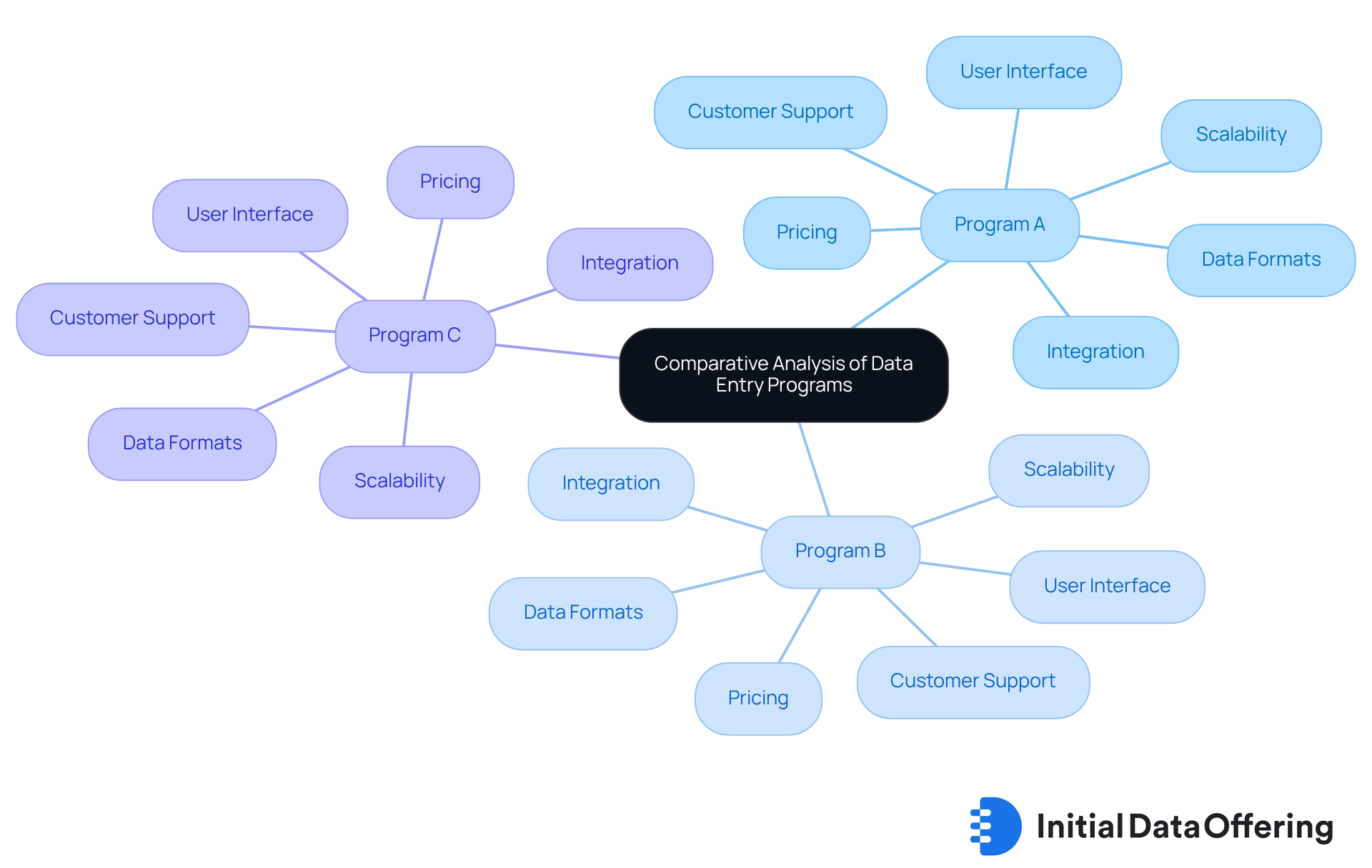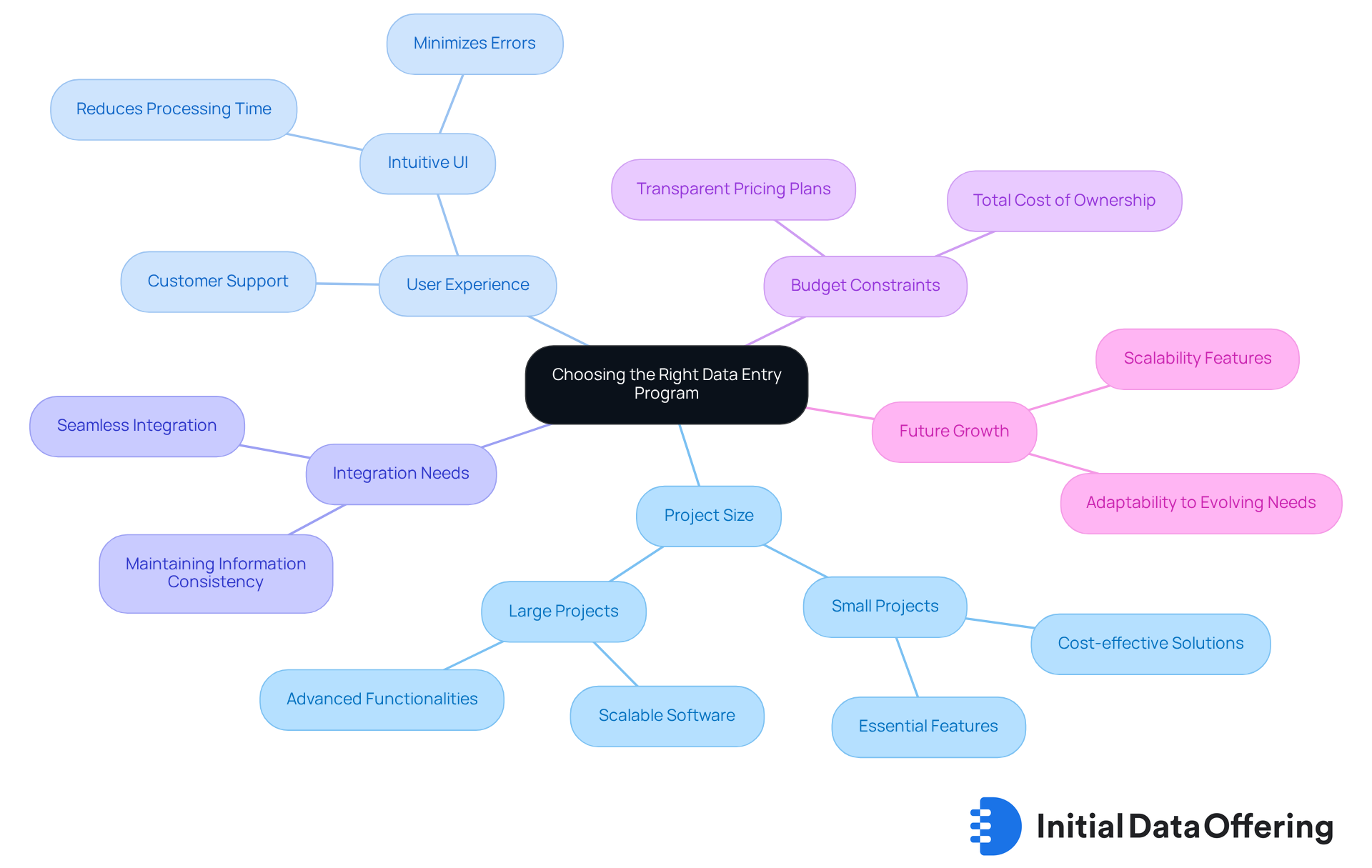Compare Top Data Entry Programs for Market Research Needs

Compare Top Data Entry Programs for Market Research Needs
Overview
The article offers a comprehensive overview of top data entry programs specifically designed for market research needs. It emphasizes the importance of selecting the right software based on various criteria, which is crucial for effective data management. Key features such as user interface, integration capabilities, scalability, and cost are outlined, providing a clear understanding of what to consider when choosing a program.
In its comparative analysis of three leading programs, the article highlights how these factors influence the effectiveness and efficiency of data management in market research. By examining the advantages and benefits of each program, readers can appreciate how tailored software can enhance their data handling processes.
How can the right data entry program impact your market research outcomes? By considering the outlined features and their implications, professionals can make informed decisions that align with their specific needs. Ultimately, the article serves as a valuable resource for anyone looking to optimize their data management strategies in the context of market research.
Introduction
The landscape of market research is rapidly evolving, and the tools used to manage data entry are at the forefront of this transformation. As organizations increasingly rely on accurate and efficient data management to drive strategic decisions, the importance of selecting the right data entry program cannot be overstated. This article delves into the essential features and criteria for evaluating top data entry programs, offering insights into how these tools can enhance research capabilities.
But with so many options available, how can one determine which program truly meets their unique market research needs? This question is crucial, as the right data entry program can significantly impact the quality and effectiveness of research outcomes. By understanding the features, advantages, and benefits of various programs, organizations can make informed decisions that align with their specific requirements.
Understanding Data Entry Programs in Market Research
Data entry programs serve as essential software solutions that simplify the input, management, and analysis of information, particularly in market research. These data entry programs play a vital role in ensuring that information gathered from diverse sources is accurately documented and readily accessible for analysis. By preserving information integrity and minimizing errors, they significantly enhance processing efficiency. The automation of repetitive tasks allows market researchers to concentrate on analyzing data and deriving actionable insights, which are critical for informed decision-making in competitive landscapes.
As industry specialists emphasize, "Automation in information input not only decreases human mistakes but also accelerates the processing timeline, facilitating quicker insights." Moreover, many data entry programs seamlessly integrate with analytical tools, creating a fluid workflow from data collection to analysis and reporting. The adaptability of these market research tools renders them suitable for businesses across various sizes and sectors.
As the market research software landscape evolves, the anticipated growth of the information input software market—projected to exceed $120 billion by 2030, with a compound annual growth rate (CAGR) of over 5.8% from 2023 to 2030—underscores the increasing reliance on these tools for effective information management. This trend signifies a broader shift towards information-driven decision-making, where precision in information input is crucial for obtaining reliable insights and enhancing marketing strategies.

Criteria for Comparing Data Entry Programs
When evaluating data entry programs for market research, several key criteria should be prioritized:
-
User Interface and Usability: A user-friendly interface is essential for enabling users to navigate the program efficiently, minimizing the need for extensive training. Programs that prioritize intuitive design can significantly enhance user satisfaction and productivity.
-
Information Import and Export Capabilities: The capacity to seamlessly import information from various sources and export it in multiple formats is crucial for flexibility in management. Effective import/export capabilities can reduce processing time by up to 40%, allowing for quicker insights and decision-making. Additionally, manual information input costs American firms approximately USD 28,500 per worker annually, emphasizing the significance of automation in decreasing these expenses.
-
Integration with Other Tools: Compatibility with analytical and reporting instruments enhances the overall functionality of the entry program. Programs that integrate effectively with current systems can streamline workflows and enhance information accuracy.
-
Information Validation Features: Strong validation mechanisms are essential for preserving accuracy and integrity, greatly minimizing the risk of mistakes. Establishing validation rules can improve information quality, ensuring that only properly formatted entries are input into the system.
-
Scalability: The system should be capable of handling increasing volumes of data as research needs expand. Scalable solutions enable organizations to grow without the necessity for frequent system modifications.
-
Cost: Evaluating the pricing structure in relation to the features offered is essential for budget-conscious organizations. Understanding the total cost of ownership, including potential hidden costs, can aid in making informed decisions.
-
Customer Support and Training: Access to dependable customer assistance and extensive training materials can greatly influence user experience and system effectiveness. Organizations should consider vendors that offer robust support to ensure smooth implementation and ongoing usage.
Industry leaders stress that effective information import/export capabilities are essential for any record management software, as they directly impact operational efficiency and information integrity. By concentrating on these standards, organizations can select the most suitable data entry programs to meet their market research requirements.

Comparative Analysis of Leading Data Entry Programs
In this comparative analysis, we examine three leading data entry programs: Program A, Program B, and Program C.
Program A offers an intuitive and easy-to-navigate user interface, enhancing user experience. This design not only makes it accessible but also encourages efficient use. It supports multiple formats, including CSV and Excel, facilitating seamless data handling, which is crucial for professionals who require versatility in their workflows. Furthermore, Program A seamlessly connects with popular analytics tools, ensuring an efficient flow of information. Its advanced information validation options improve accuracy, which is essential for maintaining data integrity. Suitable for small to medium-sized datasets, it is versatile for various applications. With mid-range pricing and flexible subscription options, it appeals to a broad user base. Additionally, 24/7 customer support is available, ensuring assistance whenever needed.
Program B, while slightly complex, requires training for new users, which may impact initial adoption. This complexity could pose challenges for teams looking to implement the software quickly. The data import and export capabilities are limited to specific formats, potentially restricting usability for some users. Although it offers basic integration capabilities, these may not meet all user needs in a rapidly evolving technological landscape. Its standard validation features are adequate for general use but lack the advanced options that some projects may demand. However, Program B is highly scalable, making it ideal for large datasets and suitable for enterprise-level applications. While it falls into a higher pricing tier, this reflects its advanced features and capabilities. Comprehensive training resources are available, aiding user onboarding and ensuring a smoother transition.
Program C presents a simple and straightforward user interface that promotes ease of use, making it an attractive option for those new to data entry software. It supports a wide range of formats, enhancing flexibility in data management. With good integration capabilities with various tools, it facilitates effective information management. However, its validation features are basic, which may suffice for smaller projects but could limit functionality for more complex tasks. Scalability is a concern, as it has limited capacity for larger datasets, which could be a drawback for growing businesses. Despite this, Program C is a budget-friendly option, making it accessible for smaller organizations. However, limited customer support hours may affect user experience during critical times.
In summary, when selecting data entry programs, it is important to consider the specific needs of your organization. Each program has distinct features, advantages, and benefits that cater to different user requirements. Which program aligns best with your operational goals?

Choosing the Right Data Entry Program for Market Research
Choosing the suitable data entry programs for market research necessitates a comprehensive assessment of particular needs and priorities. Key factors to consider include:
-
Project Size: For smaller projects, a cost-effective solution with essential features may suffice. Conversely, larger projects benefit from investing in scalable software that offers advanced functionalities to efficiently manage increased information volumes. For instance, the Coventry Panel effectively employed a flexible system to uphold their award-winning customer experience by adapting to their growing information requirements.
-
User Experience: It is crucial to prioritize programs with intuitive interfaces and robust customer support, particularly if your team lacks technical expertise. A well-designed user interface can significantly reduce processing time and minimize errors, thereby enhancing overall productivity. Research indicates that a well-structured UI can enhance input speed by up to 30% and lower error rates by 25%.
-
Integration Needs: Assess whether the software can seamlessly integrate with existing tools and systems. Effective integration is vital for maintaining information consistency and streamlining workflows. Seamless connectivity with databases ensures that information flows smoothly between systems, which is essential for operational efficiency.
-
Budget Constraints: Establish your budget and evaluate the cost against the features provided. Transparent pricing plans are essential to avoid unexpected expenses and ensure value for money. Consider the total cost of ownership, including potential hidden fees for support and updates, to make an informed financial decision.
-
Future Growth: Anticipate potential future needs and choose applications that can adapt and scale with your organization. This foresight can prevent the necessity for frequent modifications as your information requirements evolve. Opting for software with robust scalability features will ensure that it can grow alongside your organization’s demands.
By thoughtfully evaluating these factors, you can select an entry program that not only enhances your market research capabilities but also aligns with your strategic goals. As W. Edwards Deming aptly stated, 'Without data, you're just another person with an opinion,' underscoring the importance of informed decision-making in research.

Conclusion
Selecting the right data entry program for market research is crucial for enhancing efficiency and accuracy in handling information. These software solutions not only streamline the data input process but also facilitate insightful analysis necessary for informed decision-making. With the growing reliance on data-driven strategies, robust data entry tools that adapt to the evolving demands of market research have become essential.
Key criteria for evaluating data entry programs include:
- User interface
- Import/export capabilities
- Integration with other tools
- Information validation
- Scalability
- Cost
- Customer support
Each of these factors significantly influences a program's effectiveness in meeting specific organizational needs. For instance, Programs A, B, and C were compared to illustrate the diverse features and functionalities available, enabling organizations to make informed choices based on their unique requirements.
Ultimately, the selection of a data entry program should be a strategic decision that aligns with both current and future market research needs. By prioritizing user experience, integration capabilities, and scalability, organizations can ensure they choose a solution that not only meets their immediate goals but also supports long-term growth. Investing in the right data entry software is not merely a choice; it is a commitment to enhancing the quality and accuracy of market research, which is essential in today’s competitive landscape.
Frequently Asked Questions
What are data entry programs in market research?
Data entry programs are software solutions that simplify the input, management, and analysis of information, particularly in market research.
How do data entry programs benefit market researchers?
They ensure accurate documentation of information, enhance processing efficiency, minimize errors, and allow researchers to focus on analyzing data and deriving actionable insights.
What role does automation play in data entry programs?
Automation decreases human mistakes and accelerates processing timelines, facilitating quicker insights for decision-making.
Can data entry programs integrate with other tools?
Yes, many data entry programs seamlessly integrate with analytical tools, creating a fluid workflow from data collection to analysis and reporting.
Who can benefit from using data entry programs?
Businesses of various sizes and sectors can benefit from the adaptability of these market research tools.
What is the projected growth of the information input software market?
The information input software market is projected to exceed $120 billion by 2030, with a compound annual growth rate (CAGR) of over 5.8% from 2023 to 2030.
Why is precision in information input important for businesses?
Precision in information input is crucial for obtaining reliable insights and enhancing marketing strategies, signifying a broader shift towards information-driven decision-making.